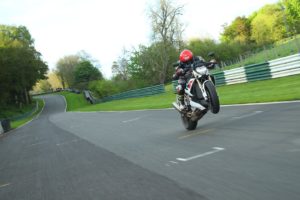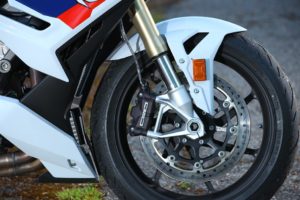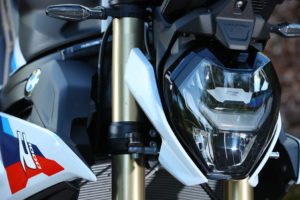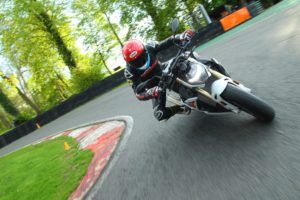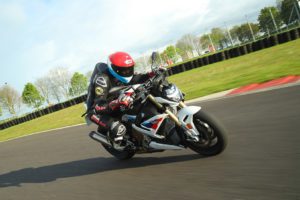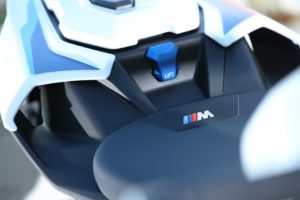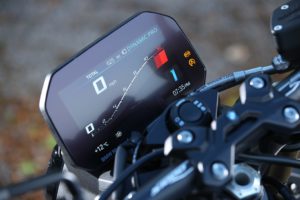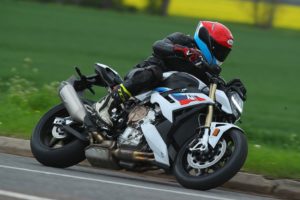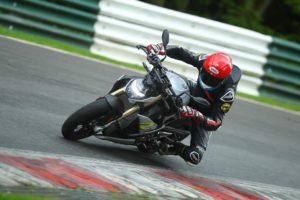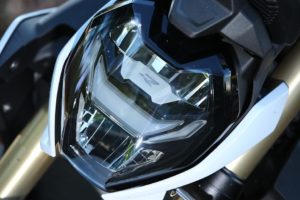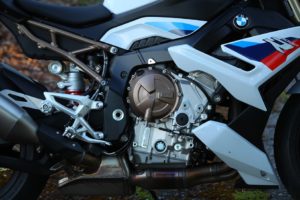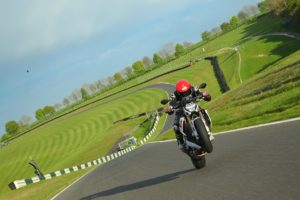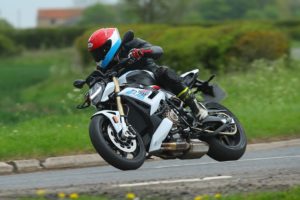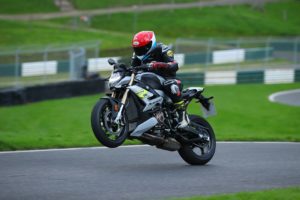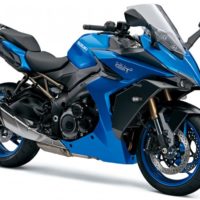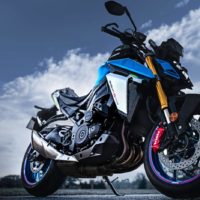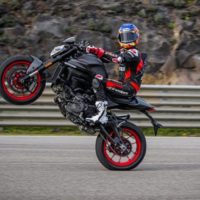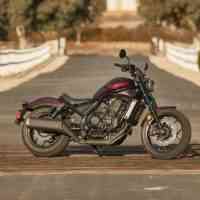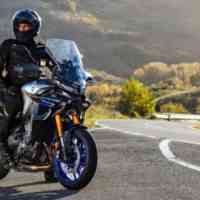BMW S1000R (2021 – on) Review
The inline four engine lacks some of the pizazz of alternative configurations, the brake calipers feel like a step-down from the old bike and it really warrants tyres better suited to the broad range of its abilities. Those are the only niggles: it otherwise blends cutting-edge performance with road sensibilities as well as anything out there.

The main advances over the old S1000R are from the chassis. The frame relies on the engine to provide structural rigidity, yet both elements (and ancillaries like the exhaust, swingarm, subframe) are all lighter. The whole bike weighs a claimed 199kg: joint-class leader with the new Triumph Speed Triple 1200 RS.
It’s narrower between your knees, and new handlebars connect you more directly with the front tyre. They’re adjustable for 10mm more forward reach from standard position, too. Suspension is all new: the rear shock in particular has a larger damping piston for better control, and the DDC semi-active control option pulls data from a new IMU and acts upon refined settings to increase ride comfort as well as control.
It’s made the S1000R much more agile, more dynamic (the previous model was a bit staid and safe by comparison), and easier to control at town speed. Extra steering lock has reduced the turning circle by 1.5m, too. High-speed direction changes are just as easy as threading through a jam to the front of the queue.

The only compromises on the chassis side are the brakes and tyres: the 1000R uses the Hayes calipers found on the R1250GS as well as the S1000RR. Owners of those were less than pleased by the switch from Brembo on those model, and the supernaked is similarly compromised. Outright power is strong, but initial lever response and progression is inconsistent, so they’re not confidence inspiring in use, which tends to make you ride with extra caution as any braking has to be planned and actioned more carefully. The ABS is at least very good: as are all the electronic systems. The new suspension balances refinement and poise brilliantly in road mode: Dynamic suspension mode was redundant until the launch moved to Cadwell Park for an evening of thrashing.
On a circuit, it’s as capable as you could wish from a road bike, yet easy to ride. Ground clearance, grip, electronic rider aid intervention, stability, feel: you name it, it’s more than good enough, with the exception of the brakes, which are even harder to apply with any precision when you’re in the upper reaches of fifth gear.
I tested a mid-spec model with stock cast wheels, as well as another with optional forged wheels which save nearly a kilo in unsprung weight. Worth it? No. it’s already light, with plenty of leverage from the wide handlebars, so the benefit of racy wheels isn’t particularly needed. Nor is the adjustabiliuty of the Dynamic Pro mode – when the preset settings are so good and you can turn them off entirely if you want, it seems silly to blow a year’s fuel money on the feature.
Giving motorcyclists what they think they want is fraught. After all, decades of sportsbike buyers shouting “More! Faster! Lighter!” has resulted in bikes so focused, few actually buy them. Super nakeds have provided some antidote to that, but those too are increasingly close to sportsbikes in terms of technology, and performance – Aprilia’s Tuono V4 and Ducati’s Streetfighter V4 in particular. They’re sportsbikes by any other name: if you’ve built a naked streetbike so fast that downforce from wings provide a measurable benefit, that’s a sign you’ve gone too far.
BMW took a similar route to creating the S1000R, from the S1000RR superbike. The frame, swingarm, suspension and engine are the same in general, with detail changes to suit the different usage. The two previous generations have remained at least 25bhp short of the sportsbike in output though, with more midrange, whereas the Italians favour less differentiation. It may satisfy keyboard experts who demand unadulterated sportsbike thrills with flat handlebars, but relatively few are sold.
The new S1000R may appear to have gone down that path: it has again taken its major componentry from the latest generation of double-R, which is packs over 200bhp at the wheel with more intense focus than ever. Refreshingly, it hasn’t and peak power remains the same as the old model: 165bhp.

The S1000RR uses Shiftcam technology, which provides two camshaft lobes for each valve – one with reduced lift for low rpm torque and combustion efficiency to satisfy Euro5, another that is engaged at 8000rpm to feed the motor’s hunger for fuel and air up to 14,000rpm. The naked does without the complexity, and redundant top-end power and a conventional camshaft profile matches the RR up to 10,000rpm before falling behind the superbike and revving to a lower 12,750rpm ceiling.
There are gains lower down, so the crucial area ‘under the curve’ is greater. At road speeds, more is available, and you don’t have to be riding at prison speeds to experience the best of it. I rode it on the roads of north Lincolnshire at the launch, and it proves to be everything you’d expect from an S1000 derivative: grunty, urgent with a flat power curve and flawless throttle response. The first three gears haven’t changed, but fourth to sixth are all taller, even compared to the S1000RR.
The broad torque spread allows a wider ratio spacing – you rarely need to stab it down to get the response you need, and if you want to kick back and cruise, the rpm drop right down for reduced consumption and vibes. Which is just as well: unplesasant high-frequency vibes have plagued the S1000 series for years, and they’re not resolved here. Hold it above 7000rpm for too long and your fingertips won’t appreciate the buzzing they’re subjected to. But 70mph in top requires just 4000rpm, and creeping up a bit more for a brisk but not mickey-taking motorway still keeps it running at around 5000rpm.
The 2021 BMW S1000R is based heavily on the fully-faired S1000RR superbike. Being a brand-new model, it’s hard to judge reliability, but BMW offer a three-year warranty and a strong dealer network.
What’s more, our owners’ reviews of the current RR superbike reveal five-star ratings for reliability, meaning you shouldn’t have anything to worry about.

The super naked segment is the healthiest it’s ever been, with almost all major manufacturers throwing their hat into the ring with an all-singing-all-dancing performance upright.
Watch MCN’s 2020 super naked shootout video here:
Check out many of the main rivals to the 2021 BMW S1000R below…
The 2021 BMW S1000R gets three rider modes, variable throttle/power maps, adjustable cornering-sensitive traction control, adjustable wheelie control, adjustable engine braking management, adjustable cornering ABS, six-axis IMU, up/down quickshifter, cruise control, hill-hold control and Bluetooth connectivity. There’s also optional semi-active suspension control and a fourth riding mode.

The inline four engine lacks some of the pizazz of alternative configurations, the brake calipers feel like a step-down from the old bike and it really warrants tyres better suited to the broad range of its abilities. Those are the only niggles: it otherwise blends cutting-edge performance with road sensibilities as well as anything out there.

The main advances over the old S1000R are from the chassis. The frame relies on the engine to provide structural rigidity, yet both elements (and ancillaries like the exhaust, swingarm, subframe) are all lighter. The whole bike weighs a claimed 199kg: joint-class leader with the new Triumph Speed Triple 1200 RS.
It’s narrower between your knees, and new handlebars connect you more directly with the front tyre. They’re adjustable for 10mm more forward reach from standard position, too. Suspension is all new: the rear shock in particular has a larger damping piston for better control, and the DDC semi-active control option pulls data from a new IMU and acts upon refined settings to increase ride comfort as well as control.
It’s made the S1000R much more agile, more dynamic (the previous model was a bit staid and safe by comparison), and easier to control at town speed. Extra steering lock has reduced the turning circle by 1.5m, too. High-speed direction changes are just as easy as threading through a jam to the front of the queue.

The only compromises on the chassis side are the brakes and tyres: the 1000R uses the Hayes calipers found on the R1250GS as well as the S1000RR. Owners of those were less than pleased by the switch from Brembo on those model, and the supernaked is similarly compromised. Outright power is strong, but initial lever response and progression is inconsistent, so they’re not confidence inspiring in use, which tends to make you ride with extra caution as any braking has to be planned and actioned more carefully. The ABS is at least very good: as are all the electronic systems. The new suspension balances refinement and poise brilliantly in road mode: Dynamic suspension mode was redundant until the launch moved to Cadwell Park for an evening of thrashing.
On a circuit, it’s as capable as you could wish from a road bike, yet easy to ride. Ground clearance, grip, electronic rider aid intervention, stability, feel: you name it, it’s more than good enough, with the exception of the brakes, which are even harder to apply with any precision when you’re in the upper reaches of fifth gear.
I tested a mid-spec model with stock cast wheels, as well as another with optional forged wheels which save nearly a kilo in unsprung weight. Worth it? No. it’s already light, with plenty of leverage from the wide handlebars, so the benefit of racy wheels isn’t particularly needed. Nor is the adjustabiliuty of the Dynamic Pro mode – when the preset settings are so good and you can turn them off entirely if you want, it seems silly to blow a year’s fuel money on the feature.
Giving motorcyclists what they think they want is fraught. After all, decades of sportsbike buyers shouting “More! Faster! Lighter!” has resulted in bikes so focused, few actually buy them. Super nakeds have provided some antidote to that, but those too are increasingly close to sportsbikes in terms of technology, and performance – Aprilia’s Tuono V4 and Ducati’s Streetfighter V4 in particular. They’re sportsbikes by any other name: if you’ve built a naked streetbike so fast that downforce from wings provide a measurable benefit, that’s a sign you’ve gone too far.
BMW took a similar route to creating the S1000R, from the S1000RR superbike. The frame, swingarm, suspension and engine are the same in general, with detail changes to suit the different usage. The two previous generations have remained at least 25bhp short of the sportsbike in output though, with more midrange, whereas the Italians favour less differentiation. It may satisfy keyboard experts who demand unadulterated sportsbike thrills with flat handlebars, but relatively few are sold.
The new S1000R may appear to have gone down that path: it has again taken its major componentry from the latest generation of double-R, which is packs over 200bhp at the wheel with more intense focus than ever. Refreshingly, it hasn’t and peak power remains the same as the old model: 165bhp.

The S1000RR uses Shiftcam technology, which provides two camshaft lobes for each valve – one with reduced lift for low rpm torque and combustion efficiency to satisfy Euro5, another that is engaged at 8000rpm to feed the motor’s hunger for fuel and air up to 14,000rpm. The naked does without the complexity, and redundant top-end power and a conventional camshaft profile matches the RR up to 10,000rpm before falling behind the superbike and revving to a lower 12,750rpm ceiling.
There are gains lower down, so the crucial area ‘under the curve’ is greater. At road speeds, more is available, and you don’t have to be riding at prison speeds to experience the best of it. I rode it on the roads of north Lincolnshire at the launch, and it proves to be everything you’d expect from an S1000 derivative: grunty, urgent with a flat power curve and flawless throttle response. The first three gears haven’t changed, but fourth to sixth are all taller, even compared to the S1000RR.
The broad torque spread allows a wider ratio spacing – you rarely need to stab it down to get the response you need, and if you want to kick back and cruise, the rpm drop right down for reduced consumption and vibes. Which is just as well: unplesasant high-frequency vibes have plagued the S1000 series for years, and they’re not resolved here. Hold it above 7000rpm for too long and your fingertips won’t appreciate the buzzing they’re subjected to. But 70mph in top requires just 4000rpm, and creeping up a bit more for a brisk but not mickey-taking motorway still keeps it running at around 5000rpm.
The 2021 BMW S1000R is based heavily on the fully-faired S1000RR superbike. Being a brand-new model, it’s hard to judge reliability, but BMW offer a three-year warranty and a strong dealer network.
What’s more, our owners’ reviews of the current RR superbike reveal five-star ratings for reliability, meaning you shouldn’t have anything to worry about.

The super naked segment is the healthiest it’s ever been, with almost all major manufacturers throwing their hat into the ring with an all-singing-all-dancing performance upright.
Watch MCN’s 2020 super naked shootout video here:
Check out many of the main rivals to the 2021 BMW S1000R below…
The 2021 BMW S1000R gets three rider modes, variable throttle/power maps, adjustable cornering-sensitive traction control, adjustable wheelie control, adjustable engine braking management, adjustable cornering ABS, six-axis IMU, up/down quickshifter, cruise control, hill-hold control and Bluetooth connectivity. There’s also optional semi-active suspension control and a fourth riding mode.

 Sign in
Sign in
